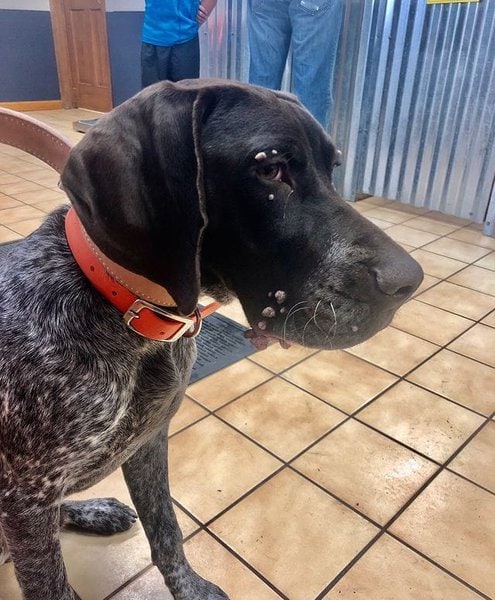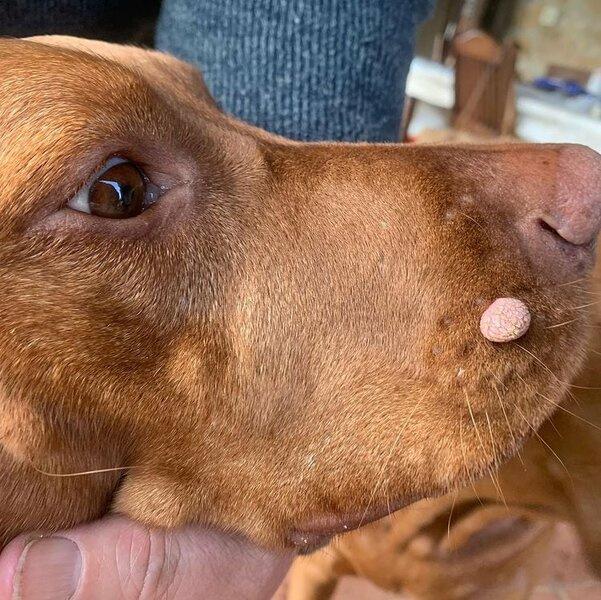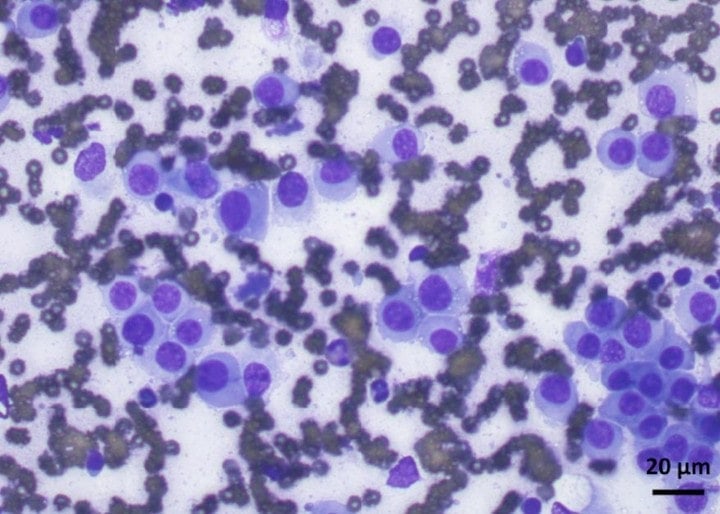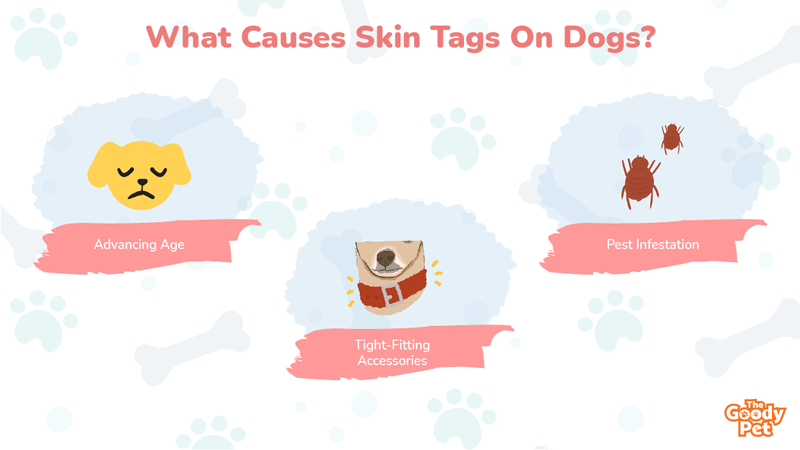Skin tags are small, fleshy growths that protrude from the skin and can be found anywhere on the body. While they aren’t harmful to dogs, they can be unsightly and sometimes bothersome.
While skin tags are generally harmless, some pet parents prefer to have them removed for cosmetic reasons. If the skin tag is bothering your dog or you simply don’t like the way it looks, your veterinarian can remove it in a simple outpatient procedure.
In this blog post, we’ll discuss everything you need to know about skin tags on dogs – from causes and treatments to prevention. So read on to learn more!
What Are Skin Tags On Dogs?

Skin tags on dogs are small growths containing skin and connective tissue including fat.
They are also known as fibropapillomas or fibrin tags due to the fibrous nature of the cells at a cellular level. Skin tags are not only painless but also harmless and are only ever removed for aesthetic purposes.
Skin tags can appear randomly all over the dog’s body but are more common on the face and the chest areas.
They vary in terms of color, firmness, and size. Some dog skin tags are no bigger than a grain of rice, while others can be as large as a grape. The color of a dog’s skin tag can also vary, with some being pink or red, and others being black or brown.
As for firmness, some dog skin tags are quite soft and easily compressible, while others are quite firm. And finally, in terms of size, some dog skin tags are very small while others can be quite large.
What Causes Skin Tags On Dogs?

For the most part, the appearance of skin tags on dogs is spontaneous, which means that no specific causes can be pinpointed.
There are many potential causes of skin tags on dogs, but the most common is simply genetics. Some dogs are simply more prone to developing them than others. Other potential causes include obesity, hormonal imbalances, and even certain types of infections.
However, in most cases, the exact cause of skin tags on dogs remains unknown. Here are some causes that some experts and researchers have agreed upon.
Advancing Age
Skin tags are common in middle-aged to old dogs. In these cases, they appear mainly around the face and occur in multiple numbers.
Tight-Fitting Accessories
This includes dog clothes as well as tight collars and harnesses. The friction between the skin and these accessories is believed to cause the overgrowth of cells leading to the tags.
Excessive Grooming
In this case, it is too much washing that could be causing all the problems. This is because the process strips the skin and fur of natural moisture and oils, leaving it vulnerable to several issues, including skin tags.
Pest Infestation
This includes mites, fleas, and ticks. Their activities on the dog’s skin cause irritation both locally and on the entire body. The resulting inflammation and healing down the line could be associated with overactive fibroblasts resulting in the tags.
Large Dog Body Size
Finally, large dog body size has been associated with dog skin tags. This includes both large breeds and overweight small and medium breeds. In this case, the tags mainly appear in high friction areas like the neck and skin rolls.
Is My Dog’s Skin Tag Cancerous?

Dog skin tags are not cancerous by nature but are instead benign growths that pose no danger whatsoever to the dog.
However, they may resemble some cancerous lesions, which is why it is important to keep an eye on them for any changes. Here are some of the key differences that would raise your alarm to something more ominous.
Color
More often than not, skin tags on dogs are exactly the same color as the rest of the skin. Only rarely may there be some form of discoloration, which is typically subtle.
With skin cancers (learn more in our highly specialized article on “Dog Skin Cancer: Types, Symptoms, and Treatment“), on the other hand, the color change is hard to miss. For example, melanomas appear dark red to black in color, while other tumors may appear as hot spots.
Size
Skin tags are usually very small and are known for their thin bases. Cancers, on the other hand, tend to be very large, which is a result of their aggressive infiltration into surrounding tissues.
Rate Of Growth
Skin tags appear and grow very slowly. They also tend to reach a limit, after which there may be months or even years without any progress.
Skin cancers, on the other hand, grow pretty rapidly, and what was a small lesion today could be a massive sore in a few months.
Pain
Another defining feature is the fact that cancerous skin lesions tend to be very painful, unlike skin tags. In some instances, they could also be itchy. So if you notice a growth that your dog isn’t comfortable having touched, then it could be a cancerous tumor.
Bleeding And Ulceration
Finally, cancerous skin tags often look like open wounds and may ulcerate and bleed. This is particularly common with mast cell tumors.
How Do You Treat Skin Tags On Dogs?

Honestly speaking, there is no need to get rid of a skin tag on your dog. They are not painful and they are harmless. There is also the possibility that doing it wrong could lead to more problems including skin infections.
However, if for whatever reason you are set on getting rid of them then you need how to get rid of them properly. It is also important to make sure you are dealing with a skin tag and not something like a cancerous tumor, a tick, or even a dog wart in which case all the information we provided above should come in handy.
Here are some of the safest and more effective ways to get rid of skin tags on dogs naturally.
Tea Tree Oil
In concentrated amounts, tea tree oil has drying effects that could help you get rid of small skin tags on your dog. Just apply some on the tag and leave it covered overnight and it should dry out and fall off within a week.
The Dental Floss Trick
Using dental floss is a good way to cut skin tags off dogs without exposing them to pain while minimizing the risk of infection. Just locate the base of the tag, tie the floss string as tightly as you can and leave it there. This will cut off blood supply to the tag which will then fall off.
Apple Cider Vinegar
Concentrated apple cider vinegar has a degenerative effect on the proteins in the skin tag. As with the tea tree oil, apply a good amount using some cotton wool and leave it overnight for 2 to 3 weeks and the cells will die and break apart.
How To Prevent Skin Tags On Dogs?

While there is no one specific cause of skin tags on dogs, you are not completely helpless in protecting your pooch from them. You just have to avoid the risk factors in which case here are the main tips to help you prevent skin tags on dogs.
Stick To A Healthy Grooming Routine
Maintaining healthy skin is crucial to preventing issues like skin tags on dogs. A wash routine with a 1 to 2-month interval using high-quality, moisturizing products is ideal for healthy and supple skin.
Deal With Pest Infestations Promptly
Long-term infestation by pests like fleas and mites results in a world of issues from eczema and skin infections to skin tags. It is therefore important to get rid of them by whatever means necessary to prevent skin tags.
Get The Right Size For All Accessories
This includes collars, harnesses, dog clothing, and even crates. Whatever restraints you use on your dog should not only be appropriately sized but also from skin-friendly material to prevent the irritation that leads to tags.
Keep Your Dog Active
Being overweight plays a role in the formation of skin tags and so, to prevent them, increased activity to maintain a healthy weight is necessary. This is the case, especially with small dog breeds that are prone to obesity and poor immunity which have been associated with skin tags on doggies.
Adopt A Healthy Diet
Speaking of healthy immunity, the dog’s diet could also do a lot to prevent skin tags. We recommend you to get Ollie for high-quality and organic ingredients. The food also includes superfood ingredients with antioxidant effects that improve immunity to prevent skin issues like tags.
Related Questions
How Much Does Dog Skin Tag Removal Cost? Having skin tags on dogs removed by a professional is the safest, fastest, and more effective solution. However, it costs more than home remedies and could set you back between $100 to $500. This depends on factors like the size, number of the tags, and the specific vet that you choose to go to.
Can You Use Human Wart Remover On Dogs? You should not use human wart remover on dogs. First off, it is never a good idea to use most human drugs on pets because the concentrations could either be dangerously high or ineffectively low. When dealing with dog skin tags, warts removers may also not be effective as warts and skin tags are completely different in structure and management.
Can You Cut Skin Tags Off With Nail Clippers? Yes, you can cut skin tags off with nail clippers. Under the right circumstances which include proper sanitization and a sharp set of clippers, it could be a fast and easy solution. However, it is not the best idea for many reasons including the fact that it could result in a lot of bleeding and the non-sterile environment puts the dog at risk of infections at the cut site.





